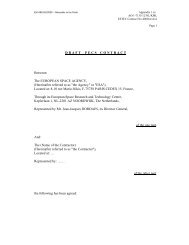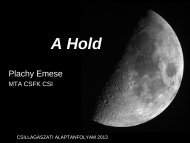Star Forming Regions in Cepheus
Star Forming Regions in Cepheus
Star Forming Regions in Cepheus
You also want an ePaper? Increase the reach of your titles
YUMPU automatically turns print PDFs into web optimized ePapers that Google loves.
42<br />
LkHα 234. Ray et al. (1990) identified an optical jet orig<strong>in</strong>at<strong>in</strong>g from this region.<br />
Mitchell & Matthews (1994) detected a molecular jet associated with LkHα 234, and<br />
Schultz et al. (1995) observed shocked molecular hydrogen <strong>in</strong> the LkHα 234 region.<br />
VLA observations by Tr<strong>in</strong>idad et al. (2004) of water masers and radio cont<strong>in</strong>uum emission<br />
at 1.3 and 3.6 cm show that the LkHα 234 region conta<strong>in</strong>s a cluster of YSOs. In<br />
a field of ∼ 5 ′′ they detected five radio cont<strong>in</strong>uum sources (VLA 1, VLA 2, VLA 3A,<br />
VLA 3B, and LkHα 234) and 21 water maser spots. These water masers are ma<strong>in</strong>ly<br />
distributed <strong>in</strong> three clusters associated with VLA 1, VLA 2, and VLA 3B. The VLA<br />
observations suggest that there are at least four <strong>in</strong>dependent, nearly parallel outflows <strong>in</strong><br />
the LkHα 234 region. Probably all sources observed <strong>in</strong> this region (∼ 5 ′′ <strong>in</strong> diameter)<br />
form a cluster of YSOs, which were born <strong>in</strong>side the same core <strong>in</strong> the NGC 7129 molecular<br />
cloud. This fact could expla<strong>in</strong> that the major axes of the outflows have nearly<br />
the same orientation. Marvel (2005) performed VLBI observations of maser sources<br />
around LkHα 234, and detected maser emission associated with LkHα 234–VLA 2<br />
and LkHα 234–VLA 3b. No maser source associated with LkHα 234 itself has been<br />
detected.<br />
Tommasi et al. (1999) obta<strong>in</strong>ed far-<strong>in</strong>frared spectra of the LkHα 234 region, us<strong>in</strong>g<br />
the Long Wavelength Spectrograph of ISO. The observed spectra are consistent with a<br />
photodissociation region, associated with not LkHα 234, but with BD +65 ◦ 1637. Morris<br />
et al. (2004) have obta<strong>in</strong>ed mid-IR spectroscopy of regions around LkHα 234, with<br />
the Spitzer Space Telescope Infrared Spectrograph (IRS). They detected warm material<br />
at 16 µm around BD +65 ◦ 1638 which clearly shows that this region is not free of gas<br />
and dust. Wang & Looney (2007) identified a group of low-mass young stars around<br />
LkHα 234 us<strong>in</strong>g the Spitzer data base.<br />
Interstellar matter associated with NGC 7129 Molecular l<strong>in</strong>e observations of the region<br />
(Bechis et al. 1978; Font, Mitchell & Sandell 2001; Miskolczi et al. 2001; Ridge<br />
et al. 2003) revealed a kidney-shaped molecular cloud of about 11 pc <strong>in</strong> extent to the<br />
east and south of the cluster. BD +65 ◦ 1637 and most of the fa<strong>in</strong>ter cluster members<br />
are found <strong>in</strong> a cavity of the cloud, bordered by a prom<strong>in</strong>ent molecular ridge, while<br />
LkHα 234, located to the east of the ma<strong>in</strong> cluster, is associated with a peak of 13 CO<br />
emission. The optical jet detected by Ray et al. (1990) is po<strong>in</strong>t<strong>in</strong>g southwest <strong>in</strong>to the<br />
cavity. Torrelles et al. (1983) and Güsten & Marcaide (1986) presented ammonia observations<br />
of NGC 7129.<br />
Matthews et al. (2003) observed the region <strong>in</strong> the 21 cm l<strong>in</strong>e of H I with an angular<br />
resolution of 1 ′ . The observations revealed a r<strong>in</strong>g of H I emission about 30 ′ <strong>in</strong> extent.<br />
The H I r<strong>in</strong>g appears to be part of the surface of a molecular cloud and is centered on a<br />
relatively dense concentration of H I with unusually wide l<strong>in</strong>e profiles and positionally<br />
co<strong>in</strong>cident with BD +65 ◦ 1638. An <strong>in</strong>frared po<strong>in</strong>t source, IRAS 21418+6552, co<strong>in</strong>cides<br />
with<strong>in</strong> the positional errors with the H I knot.<br />
A cont<strong>in</strong>uum source co<strong>in</strong>cident with BD +65 ◦ 1638 has also been detected at 1420<br />
MHz, which shows a significant extension to the northeast overlapp<strong>in</strong>g the position<br />
of LkHα 234. Compar<strong>in</strong>g the radio cont<strong>in</strong>uum data with other radio observations of<br />
BD +65 ◦ 1638, Matthews et al. (2003) found that BD +65 ◦ 1638 has a flat centimeterwave<br />
spectrum, consistent with an optically th<strong>in</strong> H II region around the star. The authors<br />
conclude that the physical association of the star with the H I knot <strong>in</strong>dicates that<br />
BD +65 ◦ 1638 belongs to a rare class of “dissociat<strong>in</strong>g stars”, hav<strong>in</strong>g an extremely young<br />
age of not more than a few thousand years. BD +65 ◦ 1638 itself is found to be a 6 M⊙<br />
star that has just emerged from its cocoon and lies on the birthl<strong>in</strong>e.


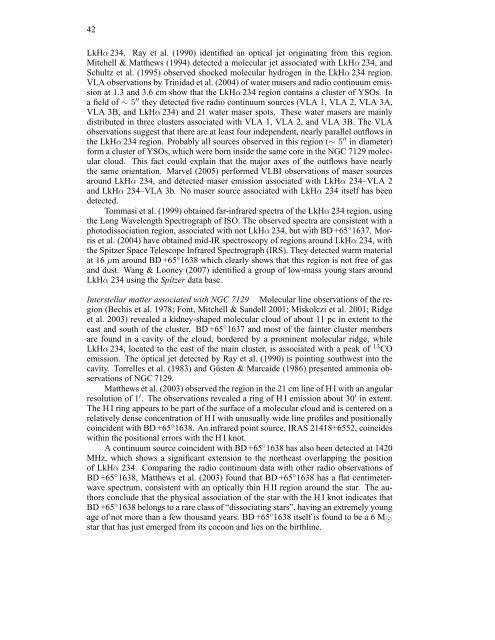


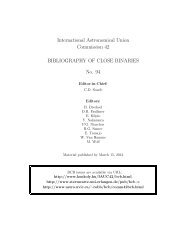

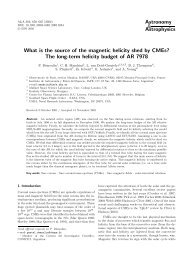


![[001] Kov5acs, G. and VetUo, B. 1979, 'Observations of Two Low ...](https://img.yumpu.com/23925638/1/190x245/001-kov5acs-g-and-vetuo-b-1979-observations-of-two-low-.jpg?quality=85)
